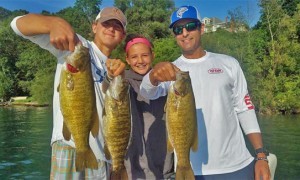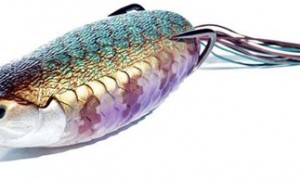[This post seems to be particularly important in light of the fact that a derby of some note is scheduled to be fished in brackish water in a couple months. What’s it called again? The ‘class’-something?! –Ed.]
What bait do you use when when you’re fishing for delta (brackish-water) bass? What prey item do you think you’re mimicking?
If you’re fishing a crawfish color and trying to mimic such “invertebrates,” you’re on the right track. But you’re not mimicking the food source coastal largies like most.
That’s one of the most interesting things found in a study of Mobile-Tensaw Delta bass by Auburn University scientists, and it appears to relate to why delta bass grow faster (if you missed part 1 of our breakdown of their paper, click here). Here’s the info – we added bold for emphasis:
> Largemouth bass relative weights across the delta were high…their diets contained high levels of fish and large macroinvertebrates.
> Increased relative weight downstream relative to upstream may indicate a benefit to inhabiting downstream habitats, possibly stemming from prey type consumed (e.g., marine versus freshwater, invertebrates [e.g., crawfish] versus vertebrates [fish]).
> Blue crabs composed a large portion of the total biomass of largemouth bass diets downstream, similar to findings in other coastal areas [just in case you think that’s limited to the Mobile region].
> In contrast, vertebrates were more important in largemouth bass diets upstream, although blue crabs remained an important prey type.
> Consumption of invertebrates or other marine influences may alter patterns of energy allocation, resulting in reduced length relative to weight [balance beam for fish!].
Table of Dietary Items
Couple notes about the table first:
> The diets of largemouth bass were diverse (Table 1). As a percent of total biomass, blue crabs were the most important item in the diets of downstream fish in all years.
> The diets of upstream fish were dominated by fat sleepers, crayfish, redspotted sunfish, bluegill and greater siren, but blue crabs were always the third or fourth most important prey for upstream fish.
More
































AlexV
December 23, 2010 at 2:07 pm
Yup, they’ll eat whatever fits in their mouth! I’ll bet those blue crab fish even have a slight blue tint in their fins and plump bellies!.
Steven Rock Rockweiler
December 28, 2011 at 11:10 am
I was reading an earlier article on the Mobile Bay study about bass not migrating very far on Deltas. I do not know much about the Mobile Bay bass, but the bass on the Louisiana Delta can migrate far distances. I have fished this Delta since age 8, that’s 50 years, strictly for bass. I have tagged hundreds of bass over the years and have had people call my number. Most think they have won CCA or other contest, but then they find out I tagged them myself and was just looking for the area they caught the bass and the weight,( if they happened to weigh it). A lot of folks went by studies conducted on inland reservoirs over the years, and these studies showed that most bass spend their entire life cycle in about a quarter mile area. We are just getting info from recent studies on open estuaries. There was a recent study in the Chesapeake Bay watershed, I believe in 2009 by the Maryland Dept. of Natural Resources, that showed some of the bass implanted with transmitters migrated significant distances. This was really evident when they noticed that near spawning season, certain groups would migrate across an entire bay to spawn on that side. The things I’ve noticed on this Delta is similar. The bass stay put if water ph and certain other conditions remain within certain limits. If things start to get too out of whack, they can really move. Also, I have noticed certain groups that will move distances in order to spawn in a preferred are. In fact, I have repeatedly caught the same bass,( up to 10 lbs.), each spring in the same exact spot. These bass seem to be like salmon that return to the area they were hatched.